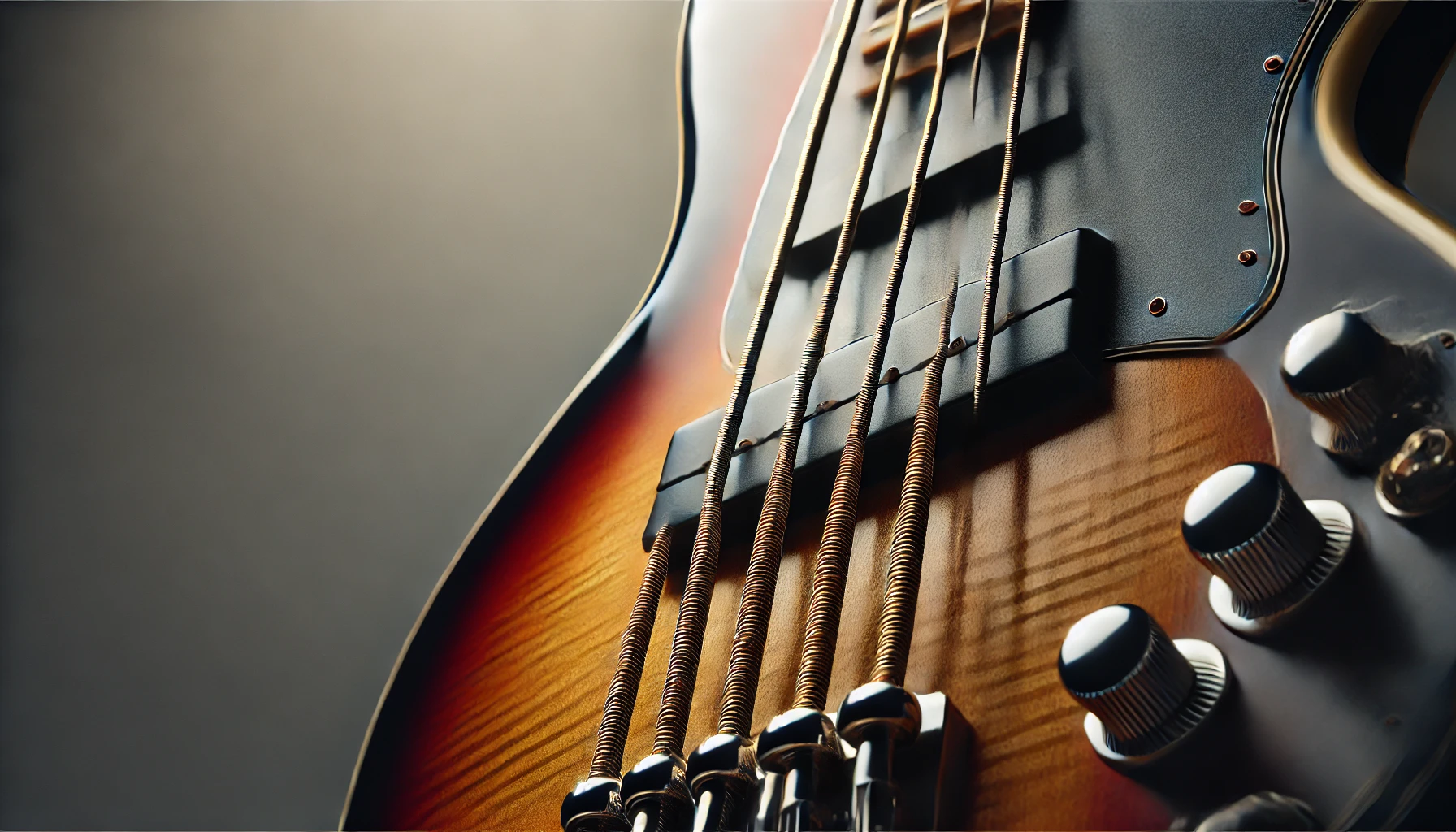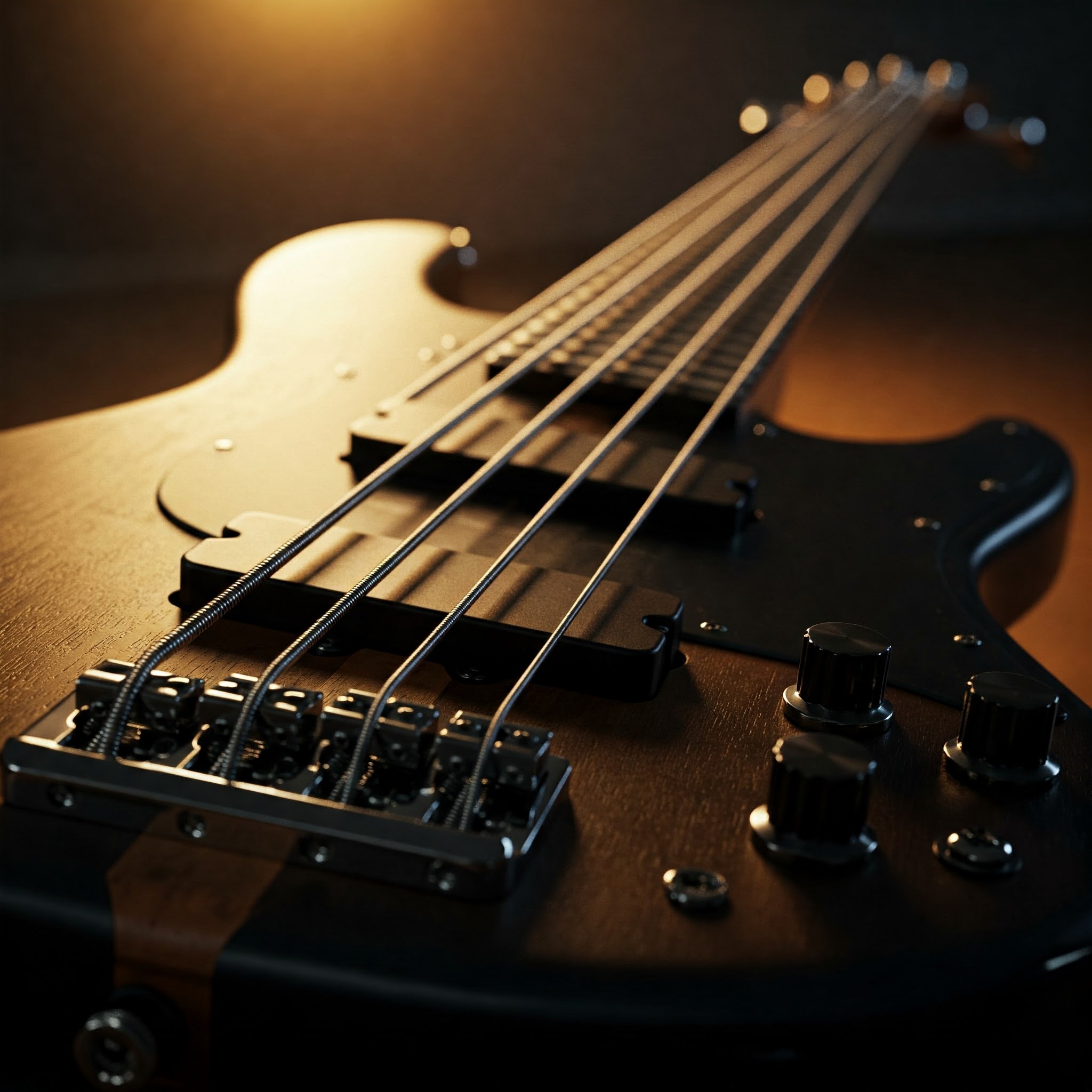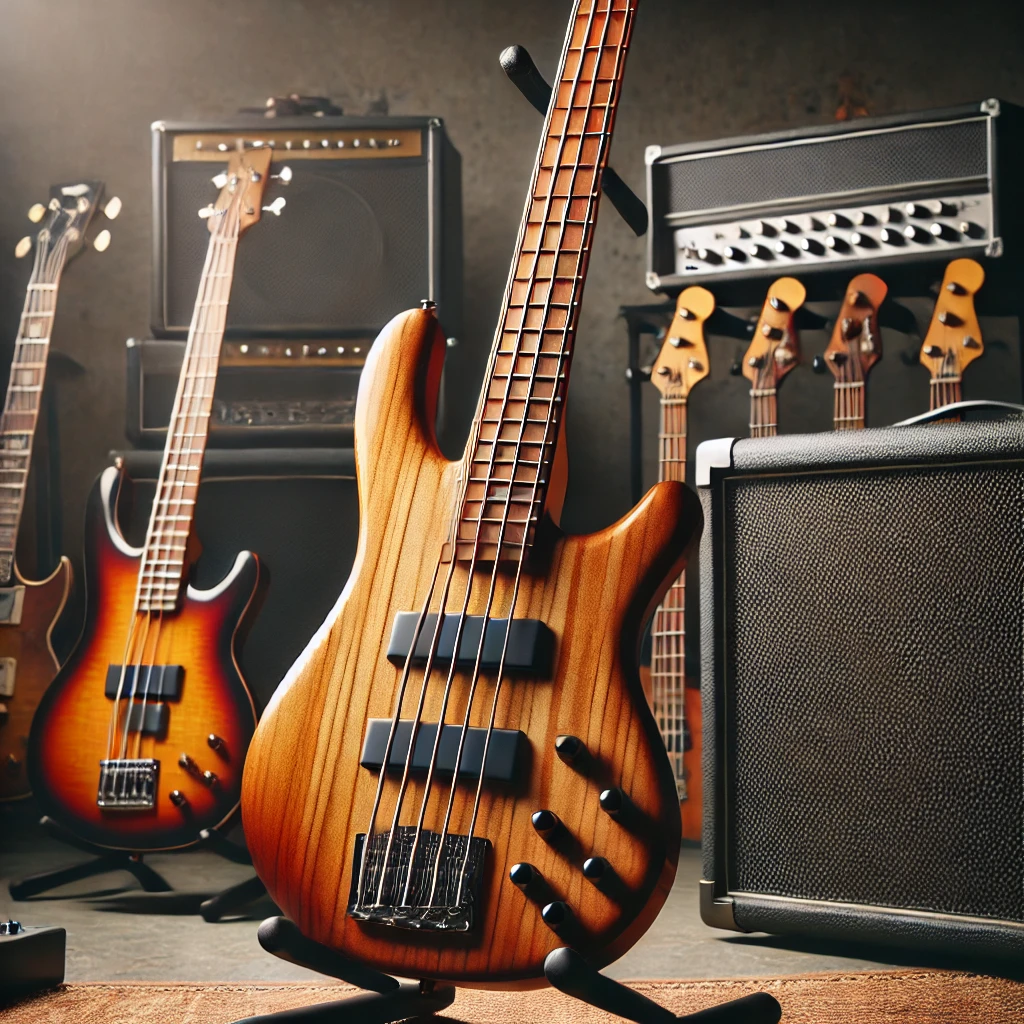The Smooth Revolution of Flatwound Bass Strings 
Have you ever picked up a bass guitar and immediately noticed something different about how it feels under your fingers? Perhaps the strings felt smoother, more comfortable, and produced a warmer, more mellow tone than what you’re used to. If so, you’ve likely encountered flatwound bass strings, the unsung heroes of many iconic bass recordings and performances throughout music history.
As a bassist for over 15 years, I’ve experimented with virtually every string type available, and flatwound bass strings continue to hold a special place in my arsenal. While roundwound strings dominate the market today, flatwounds offer a distinctive playing experience and tonal palette that simply can’t be replicated by their more common counterparts.
In this comprehensive guide, we’ll dive deep into the world of flatwound bass strings. From their unique construction and rich history to their distinctive tonal characteristics and the best options available today, this article will equip you with everything you need to know about these smooth operators of the bass world.
What Are Flatwound Bass Strings? The Basics You Should Know 
Before we explore the benefits and applications of flatwound bass strings, let’s establish a clear understanding of what makes these strings unique.
The Construction Difference
Flatwound bass strings feature a completely different wrapping technique compared to the more common roundwound strings. Here’s how they differ:


This fundamental difference in construction directly impacts everything from how the strings feel and sound to how long they last. The flat windings eliminate the tiny spaces where dirt and oil can accumulate, which not only affects the playing experience but also the string’s longevity.
Core Materials Matter
Like other bass strings, flatwounds are typically built around one of two core types:


The core material works in conjunction with the flat winding to determine the string’s overall character. Steel cores tend to provide more definition and punch, while nylon cores offer a more flexible feel and rounder tone.
The Rich History of Flatwound Bass Strings 
Interestingly, flatwound strings were the original electric bass string type when the Fender Precision Bass debuted in the early 1950s. Back then, Leo Fender designed the electric bass as an alternative to the upright bass, which traditionally used flatwound strings.
Throughout the 1950s and 1960s, virtually all recorded bass parts featured flatwound strings. Their smooth, thumpy sound defined the bass tone of Motown, early rock and roll, and jazz recordings from this era. When you listen to James Jamerson’s iconic bass lines on Motown hits or Paul McCartney’s melodic bass work with The Beatles, you’re hearing the distinctive character of flatwound strings.
Roundwound strings gained popularity in the late 1960s and 1970s as players sought brighter, more articulate tones for funk, rock, and fusion styles. However, flatwounds never disappeared completely, maintaining a devoted following among players who valued their unique characteristics.
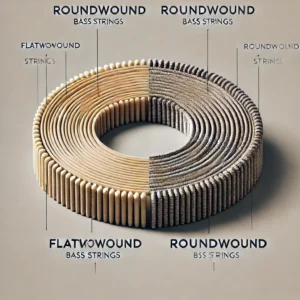
7 Compelling Benefits of Flatwound Bass Strings 
Now that we understand what flatwound bass strings are and where they come from, let’s explore the advantages they offer to bassists of various styles and preferences.
1. Smooth Playability For Extended Sessions 
One of the most immediately noticeable benefits of flatwound strings is their remarkably smooth feel. Without the ridges found on roundwound strings, flatwounds glide effortlessly under your fingers.
This smoothness translates to:
- Reduced finger fatigue during long playing sessions
- Virtually no string noise when sliding between positions
- A more comfortable experience for bassists with sensitive fingertips
- Easier execution of legato techniques like hammer-ons and pull-offs
For bassists who play for hours, whether in practice, recording, or live performance, the reduced friction can make a significant difference in comfort and endurance.
2. Distinctive Warm Tone With Rich Low End 
Flatwound strings produce a warm, focused tone with pronounced fundamental frequencies and reduced upper harmonics. This sonic signature includes:
- Rich, deep low frequencies that provide a solid foundation
- Reduced high-frequency content for a smoother, less aggressive sound
- Excellent note definition without excessive brightness
- A naturally compressed quality that sits well in a mix
This tonal profile makes flatwounds particularly well-suited for jazz, blues, R&B, and classic rock styles where a warm, supportive bass tone is desired. The reduced upper harmonics also help prevent the bass from competing with other instruments in the midrange frequencies.
3. Impressive Longevity and Value 
Perhaps one of the most practical advantages of flatwound strings is their exceptional lifespan. Due to their smooth surface and tight winding:
- Dirt, oil, and sweat can’t penetrate between windings
- The tone remains consistent for much longer periods
- Many players report using the same set for years rather than months
- The initial investment pays off through reduced replacement frequency
While flatwound strings typically cost more upfront than roundwounds, their extended usable life often makes them more economical in the long run. I’ve personally used sets of flatwounds for over two years with minimal tonal degradation, something simply not possible with roundwound strings.
4. Minimal Fret Wear For Instrument Longevity 
The smooth profile of flatwound strings results in significantly reduced wear on your bass’s frets. The flat wrap doesn’t grind against the fret material like the ridged surface of roundwounds does.
This benefit becomes increasingly important with:
- Vintage instruments where preserving original frets is a priority
- Basses with softer fret materials like nickel-silver
- Fretless basses, where string type directly affects fingerboard wear
By reducing fret wear, flatwound strings help maintain your instrument’s playability and value over time, potentially saving you money on fretwork or refrets.
5. Reduced Finger Noise For Clean Recordings 
When recording bass parts, unwanted noise from fingers sliding along the strings can become a major issue. Flatwound strings virtually eliminate this problem:
- Silent position shifts without the “squeak” common to roundwounds
- Cleaner recordings that require less editing and noise reduction
- More consistent levels throughout performances
- Less need for compression to control dynamic spikes from string noise
This characteristic makes flatwounds particularly valuable in studio settings, though live performers also benefit from the cleaner, more controlled sound.
6. Classic Vintage Tone For Authentic Sounds 
For players seeking to recreate the authentic bass tones of the 1950s and 1960s, flatwound strings are essentially mandatory. Their distinctive sound is integral to:
- The Motown sound (James Jamerson)
- Early rock and roll bass tones
- Traditional jazz walking bass lines
- The “beat group” sound of British Invasion bands
Using flatwounds instantly provides a more authentic foundation for these classic styles, though they can certainly be used in contemporary contexts as well.
7. Reduced String Tension For Comfort 
Many flatwound sets offer a slightly reduced tension compared to roundwound strings of the same gauge. This lower tension can provide:
- Easier fretting, especially for players with hand issues
- A more responsive feel with better dynamic control
- Reduced strain on the instrument’s neck
- More comfortable playing experience overall
While not universal across all flatwound brands and gauges, this characteristic can be particularly beneficial for younger players, those with smaller hands, or anyone dealing with hand fatigue or conditions like tendonitis.
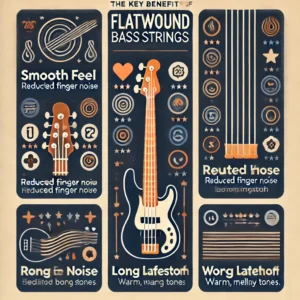
Top 5 Flatwound Bass String Sets Worth Your Investment 
With the benefits clearly established, let’s explore some of the best flatwound bass string options currently available on the market. I’ve personally tested all of these sets and can vouch for their quality and distinctive characteristics.
1. D’Addario ECB81 Chromes Flatwound Bass Strings
D’Addario’s Chromes series represents the gold standard in modern flatwound strings, offering excellent balance between vintage tone and contemporary playability.
Key features:
- Stainless steel flat ribbon wrap for smooth feel
- Medium-light tension for comfortable playability
- Bright for flatwounds, with good fundamental focus
- Available in multiple gauge options for 4, 5, and 6-string basses
These strings offer a slightly brighter tone than some other flatwounds, making them versatile enough for various musical styles while retaining the classic flatwound character.
2. La Bella 760FS Deep Talkin’ Bass Flatwound Strings
La Bella’s flatwounds are perhaps the most authentic vintage-style strings available today, virtually unchanged since the 1950s and favored by purists seeking that classic thump.
Key features:
- Exceptionally warm and deep tone
- Higher tension for a firm feel
- Pronounced fundamental with minimal overtones
- The flatwound choice for serious Motown tone seekers
These strings take longer to break in than most but reward patience with perhaps the most authentic vintage flatwound sound available today.
3. Thomastik-Infeld JF344 Jazz Flatwound Bass Strings
These premium strings from Austria represent the high end of the flatwound market, with a refined tone and feel that justifies their premium price for discerning players.
Key features:
- Silk-like smooth playing surface
- Perfectly balanced tension across all strings
- Exceptional note definition despite warm tone
- Unmatched durability even among flatwounds
While expensive, many professional jazz and session players consider these strings the ultimate flatwound option, offering nuance and refinement unmatched by other brands.
4. Ernie Ball Slinky Flatwound Bass Strings
A relatively new entry to the flatwound market, Ernie Ball brings their famous playability to a flatwound design at a more accessible price point than some competitors.
Key features:
- Slightly brighter tone than traditional flatwounds
- Tinned steel flat wrap for smooth feel
- Lower tension for easy playability
- Great “crossover” option for roundwound players
These strings offer an excellent introduction to the world of flatwounds for players coming from roundwound strings, with a less dramatic tonal shift than some more traditional options.
5. Fender 9050 Stainless Flatwound Bass Strings
From the company that created the electric bass itself, Fender’s flatwound offerings provide a balanced, versatile option with a slightly modern twist on the classic flatwound formula.
Key features:
- Stainless steel wrap for extended life
- Moderate tension balancing comfort and response
- Clear fundamental with controlled harmonics
- Excellent string-to-string balance
These strings work particularly well on Fender basses (no surprise) and offer a good middle ground between vintage warmth and modern clarity.
Comparison: Flatwound vs. Roundwound vs. Tapewound Bass Strings 
To help you make an informed decision, let’s compare flatwound strings with other popular options in a comprehensive comparison table:
| Characteristic | Flatwound | Roundwound | Tapewound |
|---|---|---|---|
| Surface Texture | Smooth | Ridged | Ultra-smooth |
| Tone | Warm, deep, thump | Bright, articulate | Extremely mellow |
| String Noise | Minimal | Significant | Almost none |
| Finger Fatigue | Low | Moderate-High | Lowest |
| Fret Wear | Minimal | Significant | Minimal |
| Lifespan | Very long (1-3+ years) | Moderate (2-6 months) | Long (1-2 years) |
| Price Range | $30-80 | $15-50 | $40-90 |
| Best For | Jazz, R&B, classic recordings | Rock, funk, slap, modern styles | Upright bass simulation |
| Playability | Smooth, effortless | Grippy, tactile | Extremely smooth |
| Attack | Soft, controlled | Sharp, aggressive | Very soft |
Ready to experience the smooth playing and warm tones of premium flatwound bass strings? Click any of the product links above to check current prices and read detailed reviews from fellow bassists who’ve made the switch!

How to Get the Most from Your Flatwound Bass Strings 
To maximize your experience with flatwound bass strings, consider these practical tips for selection, installation, and maintenance:
Choosing the Right Gauge
Flatwound strings typically feel slightly stiffer than roundwounds of the same gauge due to their construction. Consider these guidelines:
- Light gauge (40-95): Easier playability, slightly less tension and volume
- Medium gauge (45-105): Balanced tone and tension, suitable for most players
- Heavy gauge (50-110+): Maximum tone and sustain, but requires stronger hands
If you’re switching from roundwounds, you might want to start with a slightly lighter gauge than you’re used to while adjusting to the different feel of flatwounds.
Proper Installation Techniques
Installing flatwound strings properly helps ensure optimal tone and longevity:
- Clean your bass thoroughly before installation
- Install strings one at a time to maintain neck tension
- Ensure proper winding around the tuning posts (2-3 wraps)
- Stretch the strings gently after installation
- Allow 1-2 days of playing for the strings to “settle in”
Unlike roundwounds, which reach their optimal tone almost immediately, flatwounds typically require a break-in period before they develop their full tonal character.
Maintenance for Maximum Lifespan
While flatwounds last considerably longer than roundwounds, proper maintenance can extend their life even further:





With proper care, quality flatwound strings can remain in service for years rather than months, making them an excellent long-term investment.
Best Basses for Flatwound Strings: Perfect Pairings 
While flatwound strings work well on virtually any bass, certain instruments particularly complement their tonal characteristics:
Fender Precision Bass
The original P-Bass and flatwounds were made for each other, creating the foundational bass tone of countless classic recordings. The P-Bass’s split-coil pickup emphasizes the strong fundamentals that flatwounds produce, resulting in that unmistakable “thump” that sits perfectly in a mix.
Hollow and Semi-Hollow Body Basses
Basses like the Hofner “Violin” Bass (Paul McCartney’s choice) or Gibson EB-2 pair beautifully with flatwounds. The combination of acoustic resonance from the hollow body and the warm tone of flatwounds creates a rich, full sound with excellent vintage character.
Fretless Basses
Flatwound strings are practically essential for fretless basses. They not only reduce wear on the fingerboard but also produce the smooth, mwah-like tone that fretless bass players seek. Jaco Pastorius fans might note that he used roundwounds, but he was very much the exception, not the rule.
Short-Scale Basses
Basses with shorter scale lengths (30-32″ versus the standard 34″) benefit from the increased tension and focus that flatwounds provide. The combination can deliver surprising punch and clarity from a smaller instrument.
Frequently Asked Questions About Flatwound Bass Strings 
Let’s address some common questions that bassists have about flatwound strings:
How long do flatwound bass strings last? 
Flatwound bass strings typically last significantly longer than roundwounds. With proper care, a quality set of flatwounds can remain playable for 1-3 years or even longer, compared to the 2-6 month lifespan of typical roundwound strings. The smooth surface prevents dirt and oil buildup between windings, which is the primary cause of tone degradation in strings.
Are flatwound strings harder to play? 
While flatwound strings do feel different from roundwounds, they’re not necessarily harder to play. They offer less friction between your fingers and the string, making slides easier and reducing finger noise. However, they typically have slightly higher tension and less “grip” for techniques like slapping and popping. Many players actually find them more comfortable for extended playing sessions due to reduced finger fatigue.
Can you slap on flatwound bass strings? 
Yes, you can slap on flatwound strings, but the technique and resulting sound differ from slapping on roundwounds. The slap tone will be less bright and percussive, with a more muted, thumpy quality. Some legendary bassists like Larry Graham (inventor of slap bass) actually began on flatwounds. The technique may require some adaptation, but it’s certainly possible.
Do flatwound strings work on all basses? 
Flatwound strings can be used on virtually any bass guitar, including 4, 5, and 6-string models, fretted or fretless, with any scale length. They’re available in various gauges and configurations to fit most standard and extended-range instruments. However, they may alter the tonal character of active basses designed specifically for bright, modern tones.
Will I need to adjust my bass when switching to flatwounds? 
Yes, switching from roundwounds to flatwounds typically requires some setup adjustments. The different tension and mass of flatwound strings often necessitate truss rod adjustments, bridge height changes, and intonation corrections. I recommend having a professional setup done when making this switch, especially if it’s your first time using flatwounds.
Are flatwound strings only for jazz and oldies music? 
While flatwounds are strongly associated with jazz, Motown, and early rock styles, they’re not limited to these genres. Many contemporary players use flatwounds in indie rock, neo-soul, folk, country, and even some metal subgenres when a warmer, more controlled bass tone is desired. Their unique characteristics can add interesting texture to any style of music.
Should beginners use flatwound strings? 
Beginners can absolutely use flatwound strings, and they offer some distinct advantages: reduced finger pain while calluses develop, minimal string noise to build confidence in recordings, and a consistent tone that’s forgiving of technique variations. However, they do cost more initially and may make some modern techniques like slapping more challenging to learn.
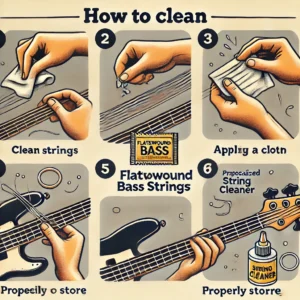
How to Incorporate Flatwound Strings into Different Playing Styles 
Flatwound strings offer unique tonal possibilities across various musical genres. Here’s how to get the most from them in different contexts:
Jazz and Walking Bass Lines 
Flatwounds excel in jazz contexts, providing the warm, defined tone that’s perfect for walking bass lines. To optimize your jazz tone with flatwounds:
- Focus on consistent plucking hand technique near the fingerboard for a fuller tone
- Use medium to firm pressure with your fretting hand for clear note definition
- Experiment with plucking closer to the bridge for more attack when needed
- Consider slightly higher action to allow strings to vibrate more freely
The combination of flatwounds and proper technique creates that classic acoustic bass-like tone that works perfectly for jazz standards and swing feels.
Classic Rock and R&B Foundations 
For authentic vintage rock and R&B tones, flatwounds are the secret ingredient. To capture those classic sounds:
- Play with your fingers rather than a pick for authenticity
- Use moderate to heavy plucking hand attack for that signature “thump”
- Focus on playing in the sweet spot between the pickups
- Lock in with the drums, emphasizing a slightly behind-the-beat feel
Listen to players like Duck Dunn (Stax Records), James Jamerson (Motown), and Carol Kaye (session legend) for inspiration on how flatwounds can anchor a rock or soul groove.
Recording Studio Applications 
In recording scenarios, flatwound strings offer significant advantages:
- Minimal string noise means cleaner tracks with less editing
- Controlled overtones prevent frequency masking of other instruments
- Consistent tone throughout long sessions
- Natural compression that requires less processing
Many studio bassists keep at least one bass strung with flatwounds specifically for recording sessions where a more controlled, mix-friendly tone is required.
Modern Indie and Alternative Sounds 
Despite their vintage associations, flatwounds can create distinctive textures in contemporary music:
- The warmth contrasts nicely with bright, digital production elements
- Their focused low end creates space for dense midrange elements
- The smooth attack allows for unique articulation possibilities
- Their subtle character can help the bass sit perfectly in complex arrangements
Bands like Khruangbin, Vulfpeck, and The National have all incorporated flatwound bass tones into modern contexts with excellent results.
Product Showdown: Battle of the Premium Flatwound Bass Strings 
Let’s take a deeper look at how three premium flatwound string sets compare across several key categories:
| Feature | D’Addario ECB81 Chromes | La Bella 760FS Deep Talkin’ | Thomastik-Infeld JF344 |
|---|---|---|---|
| Price Range | $35-45 | $40-50 | $75-90 |
| Tone Character | Balanced, slightly bright | Deep, thumpy vintage | Refined, clear fundamentals |
| Tension | Medium-light | Medium-high | Medium |
| Break-in Period | 1-2 days | 7-14 days | 3-5 days |
| Best For | All-around versatility | Authentic vintage tone | Professional jazz/studio |
| Core Material | Steel | Steel | Steel |
| Longevity | Excellent (1-2 years) | Superior (2-3+ years) | Outstanding (3+ years) |
| Flexibility | Moderate | Stiffer | Moderate-high |
| Surface Texture | Very smooth | Smooth | Silky smooth |
Ready to experience the premium feel and sound of flatwound bass strings? These top-rated sets offer exceptional quality for every style and budget. Click through to check current prices and see why thousands of bassists are rediscovering the magic of flatwounds!

The Environmental Case for Flatwound Bass Strings 
In our increasingly environmentally-conscious world, the longevity of flatwound strings presents a meaningful advantage beyond personal economics. Consider these environmental benefits:
- Reduced waste: Using strings that last 3-4 times longer means less metal waste in landfills
- Lower resource consumption: Fewer replacement sets means less manufacturing impact
- Reduced packaging and shipping: Buying strings less frequently reduces packaging materials and transportation emissions
- Extended instrument life: Less frequent string changes and reduced fret wear prolong your instrument’s useful life
While not often discussed, the sustainability aspect of flatwound strings represents a small but meaningful way that bassists can reduce their environmental footprint while enjoying superior tone and playability.
Making the Switch: Transitioning to Flatwound Bass Strings 
If you’ve decided to try flatwound bass strings for the first time, here’s a practical guide to managing the transition:
Expect an Adjustment Period
The difference between roundwounds and flatwounds is substantial. Give yourself time to adapt to:
- The smoother feel under your fingers
- The warmer, less bright tonal profile
- The different response to dynamics and articulation
- The slightly higher tension typical of most flatwounds
Most players need about 2-3 weeks of regular playing to fully adjust to the different feel and response of flatwound strings.
Start with Medium Gauge
Unless you have specific reasons to choose light or heavy strings, a medium-gauge set (typically .045-.105 for a 4-string) provides the best balance of tension, tone, and playability for first-time flatwound users.
Consider a Professional Setup
Because flatwounds differ significantly in tension and mass from roundwounds, having your bass professionally setup after installing them can make a tremendous difference in playability and sound. A good tech will adjust:
- Neck relief (truss rod)
- String height (action)
- Intonation
- Pickup height
These adjustments will ensure your bass plays its best with the new string type.
Give Them Time to Break In
Unlike roundwounds, which typically sound their best right out of the package, flatwounds require a break-in period before they develop their full tonal character. During the first 1-2 weeks:
- The strings will gradually settle in tension
- Initial brightness will mellow to the characteristic flatwound tone
- Playability will improve as the strings “wear in”
Be patient during this period—the full flatwound experience emerges after this initial break-in time.
Conclusion: Are Flatwound Bass Strings Right for You? 
After exploring the world of flatwound bass strings in depth, the question remains: are they the right choice for your playing style and musical needs?
Flatwound strings represent an excellent option if you:






However, they may not be ideal if you:




Many seasoned bassists eventually maintain multiple instruments with different string types, or at minimum, keep an extra set of roundwounds on hand for situations where that brighter tone is needed.
In my experience, trying a quality set of flatwounds is something every serious bassist should do at least once. Even if they don’t become your permanent string choice, the unique playing experience and tonal possibilities they offer will expand your understanding of the instrument and possibly open new creative avenues.
Ready to experience the smooth playing feel and warm, focused tone that only premium flatwound strings can deliver? The high-quality sets featured in this guide offer outstanding performance and value. Click any product link to check current pricing and join the thousands of bassists who’ve discovered the flatwound advantage!
More FQAs:
 What are flatwound bass strings?
What are flatwound bass strings?

 What are the benefits of using flatwound bass strings?
What are the benefits of using flatwound bass strings?

 How do flatwound bass strings compare to roundwound strings?
How do flatwound bass strings compare to roundwound strings?

 Are flatwound bass strings suitable for all music genres?
Are flatwound bass strings suitable for all music genres?

 Do flatwound bass strings last longer than roundwound strings?
Do flatwound bass strings last longer than roundwound strings?

Recommended for You:
- Electric Stand Up Bass: 7 Incredible Innovations Revolutionizing Modern Bass Playing
- The Ultimate Guide to Bass Saxophone Saxophones 2025: Unleash the Powerful Low End Sound
- Ultimate Guide to Bass Pickups: How to Achieve Incredible Sound in 2025
Disclaimer: This article contains affiliate links. If you purchase products through these links, we may earn a small commission at no additional cost to you.

